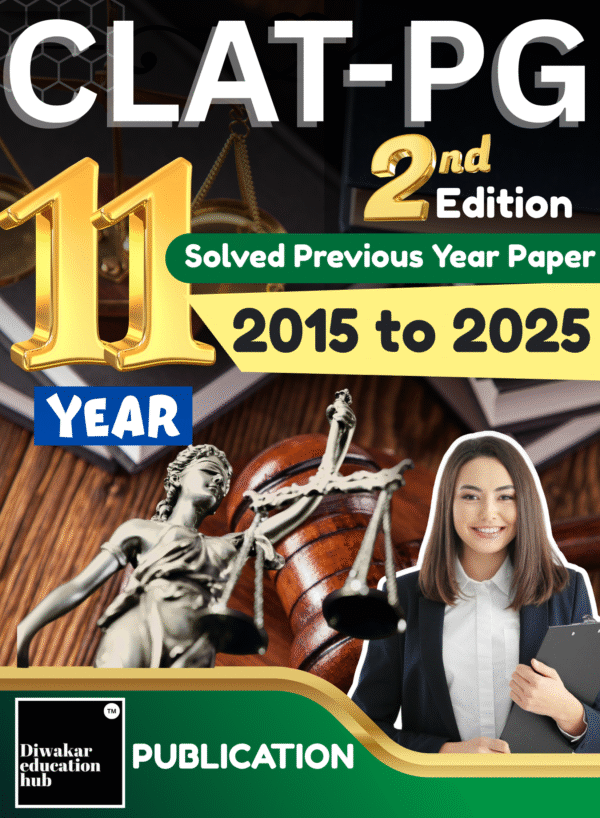
CLAT-PG List of Latest Books Chapter Wise PG LLM Courses for 2026 Exam
Preparing for CLAT-PG (LL.M. entrance) demands not only a strong grasp of core legal subjects but also the right set of books that provide conceptual clarity, updated case laws, and analytical insights. In a competitive exam like CLAT-PG, where the weightage is high on Constitutional Law, Jurisprudence, Criminal Law, Contract, and other core areas, choosing the latest and most reliable books becomes a game-changer. Each subject requires a different reading approach — while Constitutional Law and Jurisprudence demand depth and theory, subjects like Criminal Procedure or Contract Law require precision and application. Standard textbooks, combined with recent editions that incorporate the latest amendments and landmark judgments, provide the edge needed to tackle complex questions.
This chapter-wise guide lists the most recommended and updated books for CLAT-PG preparation, along with their significance in mastering the subject. The aim is not just to suggest books but also to help aspirants understand how each text strengthens their preparation strategy. By aligning reading with the syllabus and focusing on updated references, candidates can sharpen both their conceptual understanding and exam-oriented practice. Ultimately, the right book at the right stage of preparation can bridge the gap between average and exceptional performance.
Table of Contents
📚 CLAT-PG Chapter-Wise Books
| Subject / Chapter | Book Name | Author | Publisher | Approx. Price (₹) |
|---|---|---|---|---|
| Constitutional Law | Indian Constitutional Law (9th Ed, 2025) | M.P. Jain | LexisNexis | 1,995 – 2,495 |
| Jurisprudence | Jurisprudence and Legal Theory | V.D. Mahajan | Eastern Book Company (EBC) | 750 – 850 |
| Law of Crimes – IPC | Textbook on Indian Penal Code | K.D. Gaur | Universal Law Publishing | 700 – 850 |
| Law of Crimes – CrPC | Criminal Procedure | R.V. Kelkar | Eastern Book Company (EBC) | 950 – 1,100 |
| Law of Evidence | Law of Evidence | Ratanlal & Dhirajlal | LexisNexis / Bharat Law | 950 – 1,200 |
| Law of Torts & Consumer Law | Law of Torts | R.K. Bangia | Allahabad Law Agency | 600 – 750 |
| Law of Contract & Specific Relief | Law of Contract and Specific Relief | Avtar Singh | Eastern Book Company (EBC) | 950 – 1,050 |
| Company Law | Company Law (17th Ed, reprint 2024) | Avtar Singh | Eastern Book Company (EBC) | 985 – 1,095 |
| Administrative Law | Administrative Law | I.P. Massey | Eastern Book Company (EBC) | 850 – 950 |
| Public International Law & Human Rights | International Law and Human Rights | S.K. Kapoor | Central Law Agency | 650 – 750 |
| Environmental Law | Environmental Law | P. Leelakrishnan | LexisNexis / Eastern Book | 900 – 1,050 |
Most Comprehensive Solved Previous Year Paper Book
Recommended PYQ Book
-
CLAT PG [LLM] Solved Previous year Paper II Latest Book II 11 year II Year 2015 to 2025 II With Detail Solution II With Chapter Tagging & Summary II By Diwakar Education Publication
Original price was: ₹600.00.₹480.00Current price is: ₹480.00.
✅ How to Select a Good Book for CLAT-PG
1. Author’s Authority & Reputation
- Prefer standard authors (e.g., M.P. Jain for Constitution, Avtar Singh for Contract/Company Law, R.K. Bangia for Torts).
- Standard texts are widely cited by teachers, seniors, and even in law schools.
2. Updated Edition
- Law changes fast due to amendments and landmark judgments.
- Always choose the latest/revised edition (e.g., 9th Ed. M.P. Jain, 2025).
- Check whether the book covers recent case law — CLAT-PG often asks contemporary questions.
3. Coverage of Syllabus
- A good book should align with CLAT-PG syllabus (Constitution, Jurisprudence, Criminal Law, Contract, Company Law, etc.).
- Avoid overly specialized books (e.g., books meant only for PhD research) — they are not exam-friendly.
4. Clarity of Language
- The book should explain concepts simply, not confuse with jargon.
- For example, V.D. Mahajan’s Jurisprudence is simple and exam-oriented, while some foreign authors are too abstract for CLAT prep.
5. Balance Between Theory and Cases
- A good law book has:
- Statutory explanation (section-wise clarity)
- Case laws (landmark + recent)
- Critical analysis (short, not too academic)
6. Practice-Oriented Utility
- Books with examples, illustrations, and case summaries help in solving MCQs.
- E.g., K.D. Gaur’s IPC text has illustrations → very useful for PG entrance.
7. Peer & Mentor Recommendations
- Cross-check with seniors, toppers, or teachers — they know what works best for exams.
- If multiple people suggest the same book, it’s probably reliable.
8. Availability & Affordability
- Standard law books are often available in libraries, so you can test them before purchase.
- Buy only core books; for supplementary reading, rely on bare acts + online judgments.
📊 CLAT-PG Exam Pattern (Latest)
| Particulars | Details |
|---|---|
| Mode of Exam | Offline (Pen-Paper, OMR) |
| Duration | 2 Hours (120 minutes) |
| Type of Questions | Multiple-Choice Questions (MCQs) |
| Number of Questions | 120 |
| Total Marks | 120 (1 mark each) |
| Marking Scheme | +1 for correct, –0.25 for wrong |
| Subjects Covered | Core Law Subjects (see below) |
📘 Subject-Wise Weightage
| Subject / Area | Approx. No. of Questions |
|---|---|
| Constitutional Law | 30 – 40 |
| Jurisprudence | 15 – 20 |
| Other Core Law Subjects (IPC, CrPC, CPC, Evidence, Contract, Torts, Company Law, International Law, Environmental Law, Administrative Law, etc.) | 60 – 70 |
📌 CLAT-PG FAQ (Latest)
| Question | Answer |
|---|---|
| Q1. What is the mode of the CLAT-PG exam? | The exam is conducted offline (pen-paper OMR format). |
| Q2. How many questions are asked? | A total of 120 Multiple-Choice Questions (MCQs). |
| Q3. What is the marking scheme? | +1 mark for each correct answer, –0.25 mark for each wrong answer (negative marking). |
| Q4. How much time is given? | 2 hours (120 minutes). |
| Q5. What is the total score? | The paper is of 120 marks. |
| Q6. Which subjects carry the most weight? | Constitutional Law (30–40 Qs) and Jurisprudence (15–20 Qs) have the highest weightage. |
| Q7. Is there a descriptive section? | ❌ No. The descriptive section has been removed; only MCQs are asked now. |
| Q8. What is the eligibility for CLAT-PG? | LL.B. (3-year or 5-year) graduates or final-year students with at least 50% marks (45% for SC/ST). |
| Q9. Can I use CLAT-PG scores for jobs? | Yes, some Public Sector Undertakings (PSUs) use CLAT-PG scores for recruitment. |
| Q10. How important are recent case laws? | Very important ✅. Many questions are based on recent Supreme Court judgments and legal developments. |
| Q11. What is the difficulty level? | The exam is of moderate to high difficulty, testing both conceptual knowledge and case-law application. |
| Q12. When is CLAT-PG usually conducted? | In December each year, along with the CLAT-UG exam. |
| Q13. How should I prepare effectively? | Focus on bare acts + landmark & latest case laws + one standard textbook per subject + past year papers. |
| Q14. What is the best way to revise? | Prepare case law notes, practice PYQs, and revise Constitution & Jurisprudence multiple times. |
| Q15. Can I crack CLAT-PG in 3–4 months? | Yes ✅, with a focused plan (prioritizing Constitution, Jurisprudence, IPC, Evidence, and Contract). |

